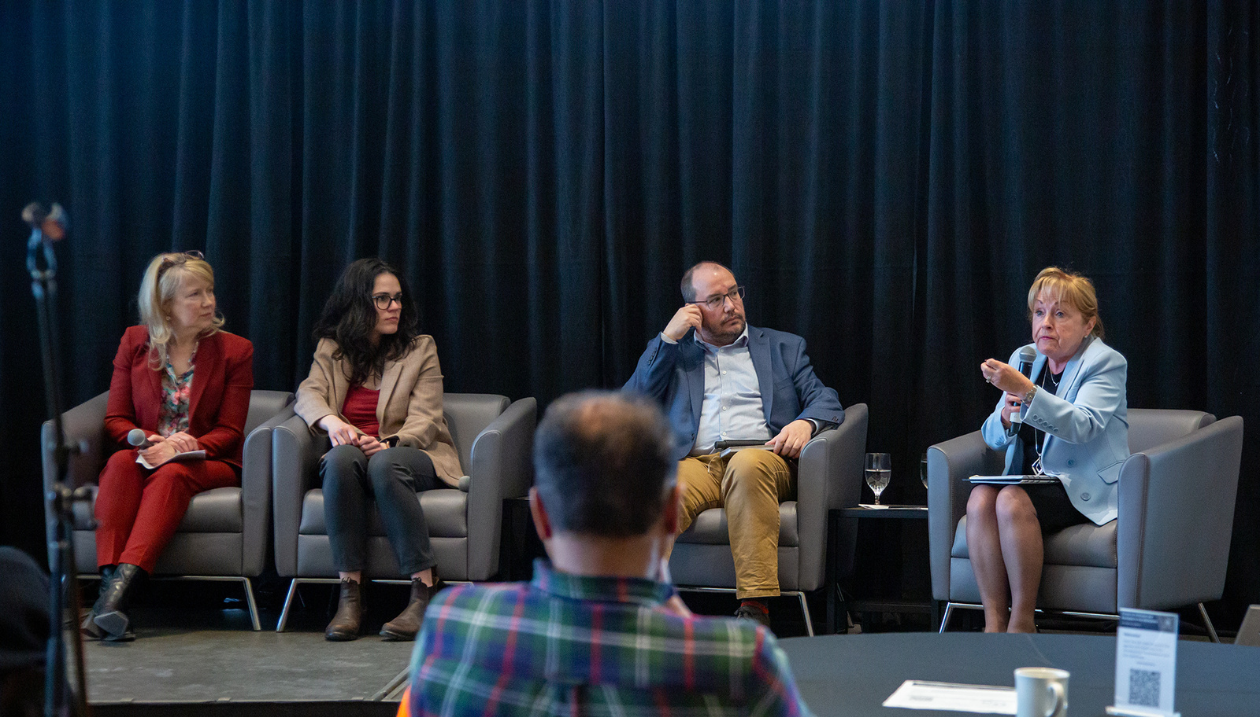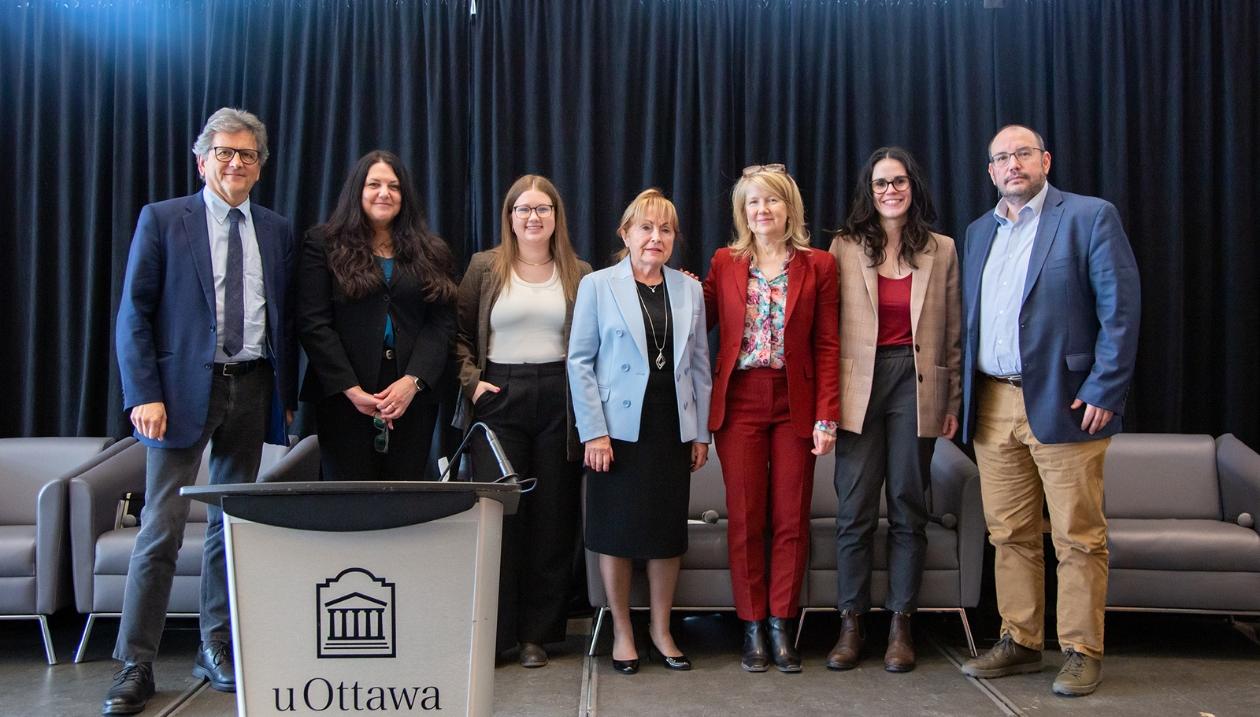Accordingly, on April 16, 2025, the University of Ottawa hosted a forum on inclusion and exclusion in the workplace as part of the Alex Trebek Forum for Dialogue, in collaboration with the LIFE Research Institute. Academic, political, professional and community-level experts came together to explore the many faces of ageism and to propose courses of action.
The event was an opportunity to collectively rethink ageing in the workplace, with an eye to inclusion, social justice and intergenerational links.
A new vision of age as a lever for inclusion
The forum kicked off with an inaugural lecture by Franco Fraccaroli, who is a professor of psychology and vice-rector for organizational wellness and employee relations at the University of Trento, Italy. Drawing on over 20 years of international research, Professor Fraccaroli drew attention to persistent stereotypes and their negative effects as he gave concrete examples of how older people can be better included in the workplace.
He emphasized that despite what some might think, ageing does not lead to a systematic decline in performance. On the contrary, older people possess a kind of “crystallized” intelligence based on experience, emotional regulation and organizational commitment. Such strengths more than compensate for certain “fluid” cognitive declines, such as slower information processing.
Professor Fraccaroli gave several examples of dogged stereotypes: older staff are less motivated, less effective or resistant to technology. These biases, often implicit, influence hiring, training and management decisions—sometimes even among workers themselves, due to an internalization of stereotypes.
Professor Fraccaroli then proposed several possible ways to deconstruct such ageist biases:
- Adapt jobs to older workers’ strengths (e.g., autonomy, variety of skills used rather than variety of tasks).
- Rely on mentoring to enhance their role and encourage intergenerational transmission.
- Train managers to avoid shortcuts based on chronological age or generational affiliation (e.g., “boomers,” “millennials”).
- Promote an organizational climate that focuses on age equity, for example through inclusive HR policies.
Ageism at the crossroads of discrimination
One of the forum’s most outstanding contributions came from sociologist Ellie Berger, a professor at Nipissing University, who presented excerpts from her book Ageism at Work: Deconstructing Age and Gender in the Discriminating Labour Market. In four field studies, she demonstrated how age stereotypes—often invisible—influence hiring, promotion and retention decisions. These forms of ageism, both explicit and subtle, have a direct impact on the mental health, financial security and professional identity of older workers.
Her analysis also brought to light an oft-ignored perspective: gendered ageism, or the combined effect of sexism and ageism. Older women are more at risk of exclusion, particularly in environments that value youth, appearance and continuous performance. Professor Berger also touched on another aspect of discrimination: ableism, i.e., stigmatization or exclusion based on functional limitations or a health condition perceived as “deviant” from the norm.
In the context of ageing in the workplace, one example of ableism occurs when it is assumed that an older person will inevitably be less productive in their job, less able to use new technologies or less resilient in the face of stress. Such perceptions can lead to refusals to hire, restricted access to training or justifications for dismissal. This is how ableism intersects with ageism, reinforcing the idea that growing old means “declining”—a reductive image that several speakers at the forum sought to deconstruct.
Amanda Bull, a doctoral student in social gerontology at McMaster University, emphasized the importance of intersectionality. In her view, ageism cannot be analyzed in a vacuum: it expresses itself differently according to gender, ethnic origin, economic status and physical ability. She also spoke of the lasting effects of the COVID-19 pandemic, which has accentuated certain age-related inequalities in the world of work, for example by bolstering the idea that the elderly are vulnerable or obsolete.
In short, both Ellie Berger and Amanda Bull invited the audience to go beyond the one-dimensional view of ageism and seriously consider the intersecting forms of discrimination that are often invisible, but that may be structurally rooted in organizational dynamics.

Recruitment and retention: When biases are implicit
Martine Lagacé, a professor in the Department of Communication who is associate vice-president of research promotion and development at the University of Ottawa, and Ariane Gauthier, a doctoral student in experimental psychology and part-time professor at the University of Ottawa, combined their expertise to present the findings of their groundbreaking study of 517 Canadian employers.
The aim of the study was to determine whether the employers were influenced by implicit age-related biases in their recruitment or retention processes. To that end, the researchers used an indirect method for detecting bias, avoiding any explicit mention of chronological age and relying instead on descriptions of traits and behaviours associated with different ages. They found that even without knowing the age of applicants, employers make judgments that reveal implicit biases influencing their recruitment and retention intentions—intentions that discriminate against older applicants and older workers.
Strikingly, older employers who participated in the study were often more inclined to choose younger candidates, suggesting a possible self-distancing phenomenon in relation to ageism
Public policies caught between mitigation and reinforcement
Patrik Marier, a political scientist who holds the Chair in Social Gerontology at Concordia University, discussed ageism from a public policy perspective. He pointed out that these policies can either mitigate or reinforce age-related inequalities, depending on whether they are based on age-related thresholds or rigidly cement them.
Marier questioned our reliance on “official” age as a criterion for access to social programs, pointing out that many of these programs are based on overly rigid thresholds,
without regard for people’s actual needs. He argued that going from 64 to 65 doesn’t suddenly transform us, but it does automatically label us as “senior citizens.”
He also decried the lack of attention paid to ageism, which is still largely ignored as a political issue, garnering just 1% of media coverage.

Valuing age diversity as a collective asset
Following the presentations, Madeleine Meilleur, a former Ontario government minister who currently serves as the executive director of the Vanier Museopark, was invited to summarize them. She called for greater recognition of generational diversity in the workplace, stressing that a cross-pollination of expertise, experience and perspectives is an asset for any organization.
She also pointed out that keeping older people in the workplace improves their social and mental health while reducing the economic costs related to their early departure from the job market.
An intergenerational issue
Over the course of the presentations, a key message emerged: ageism doesn’t just affect the elderly. As Amanda Bull pointed out, the situation varies according to gender, ethnic origin, socio-economic status, disability or the effect of the pandemic—all factors that need to be incorporated into research and policy.
In light of these findings, it becomes essential to better recognize ageism, particularly in the workplace, where it remains largely ignored. Initiatives such as intergenerational mentoring and the transfer of knowledge between generations offer concrete ways of deconstructing age-related prejudices, strengthening collaboration, and valuing skills at all stages of a professional life.
In conclusion, Linda Garcia, professor emeritus and forum moderator, summarized the issue in one powerful statement: “Once, I was in your shoes, one day you’ll be in mine”—an invitation to generational solidarity and the collective fight against age-related stereotypes.


